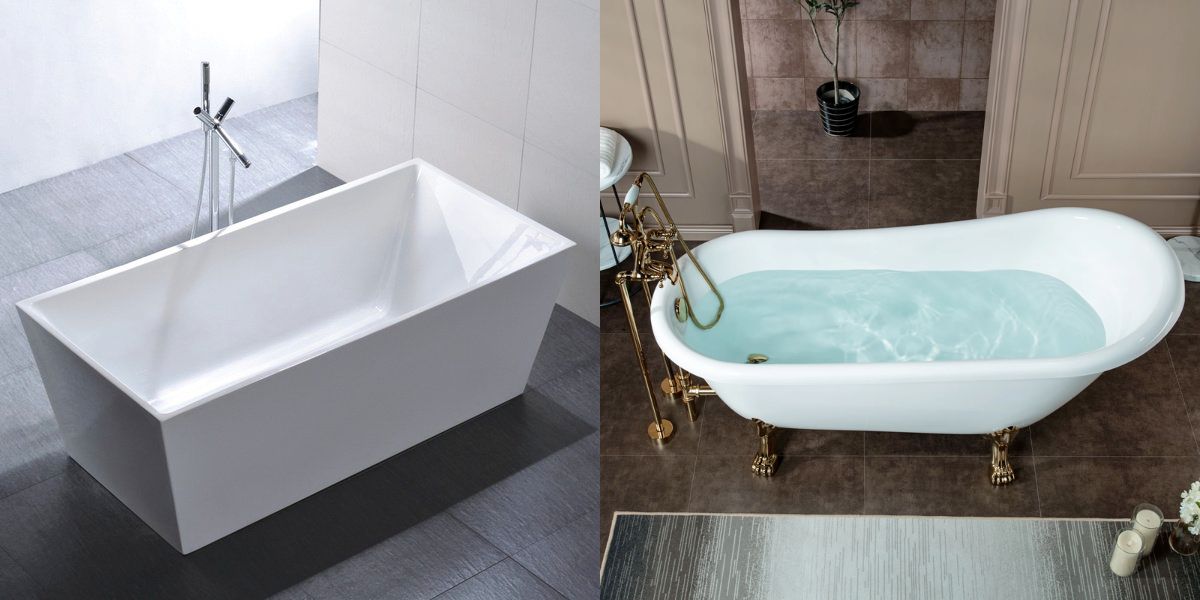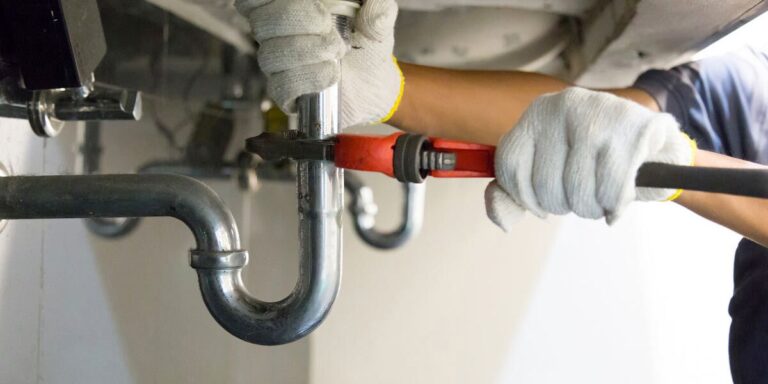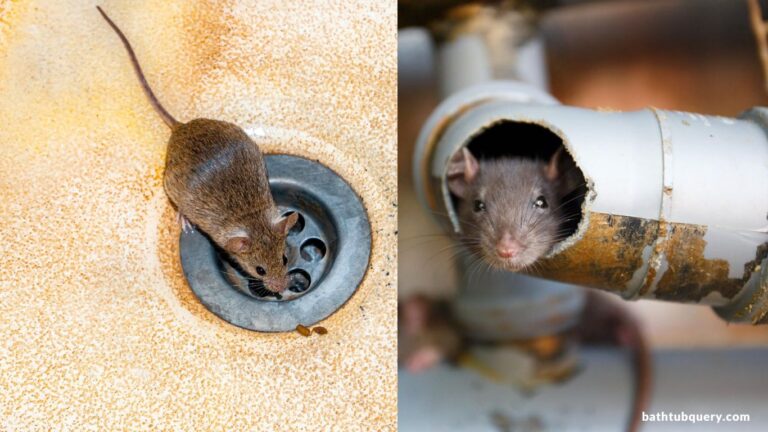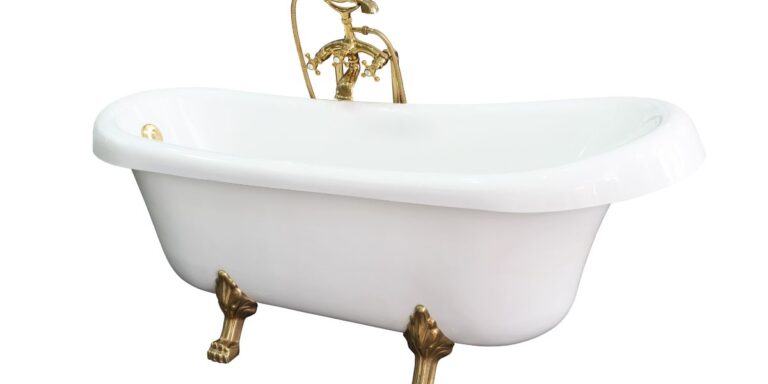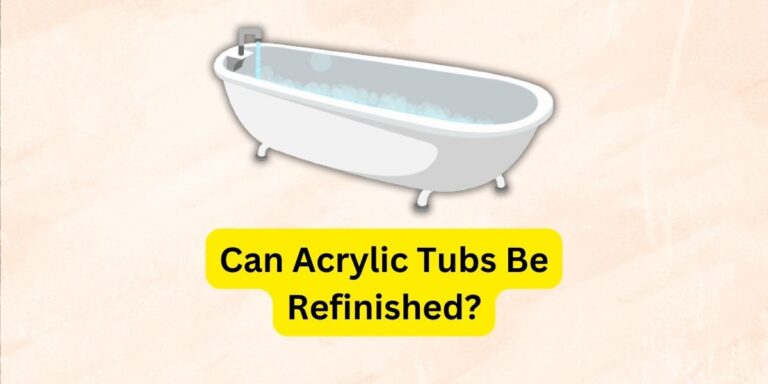The Key Differences Between Acrylic and Fiberglass Bathtubs
When it comes time to replace your old bathtub, you basically have two main material options – acrylic or fiberglass. Both have their pros and cons in terms of cost, durability, ease of cleaning, and overall aesthetics.
As you shop around and weigh up quotes from different plumbers or home improvement stores, it helps to understand what sets acrylic and fiberglass tubs apart. This will allow you to make the right long-term choice for your needs and budget.
Key Differences Summary Between Acrylic and Fiberglass Bathtubs
| Factor | Acrylic | Fiberglass |
|---|---|---|
| Cost | $500-$1500+ installed | $200-$800 installed |
| Durability | Very durable, scratch-resistant | Prone to scratches/stains |
| Style Options | Many modern and classic styles | Fairly basic styles |
| Ease of Cleaning | Glossy, wipe clean | Porous, stains more easily |
| Heat Retention | Retains heat very well | Poor heat retention |
| Repairs | Minor repairs often possible | Damage difficult to repair |
Acrylic Bathtubs
Acrylic bathtubs are composed of sheets of acrylic thermoplastic that are reinforced with fiberglass or other materials. This makes them extremely durable and resistant to scratches and damage.

The pros of acrylic tubs include:
- Durable and scratch-resistant surface – They have a high-gloss, non-porous surface that holds up well against daily use and cleaning. Minor scratches can often be buffed out.
- Variety of colors and styles – Acrylic sheets can be molded into different shapes and sizes. You can find modern curved designs, classic clawfoot tubs, rectangular styles, and more. There are many color options too, including white, biscuit, black, gray, and blue hues.
- Easy to clean – Their glossy surface does not stain easily and soap scum wipes away with minimal effort. You can use bathroom cleaners without worrying about damaging the tub.
- Retains heat – Acrylic tubs retain heat well, so your bath stays warm for longer. This helps you enjoy a more relaxing soak.
Of course, there are some downsides as well:
- More expensive – Acrylic tubs are definitely on the pricier end, ranging from $200 up to $1000 or more depending on size and style. The material and installation costs make them quite an investment.
- Can fade over time – While acrylic stands up well to cleaning, the color may fade after many years of use and exposure to bathroom light. Re-polishing it can help restore the gloss.
- Less durable than some materials – Although acrylic is extremely durable for plastic, it does not have the longevity of materials like cast iron or enamel over steel. Those options can last 50+ years with proper care.
Still, with proper maintenance an acrylic tub should provide at least 15-20 years of service. And you get the perks of easy cleaning, stylish looks, and a warm bath. For many homeowners, the pros outweigh the higher initial price tag.
See more: Are Kohler Tubs Fiberglass Or Acrylic? Which One Is Best?
Fiberglass Bathtubs
As the name implies, fiberglass bathtubs are formed from molded fiberglass. The fibers are arranged in layers and then soaked in resin to create a stiff, durable tub shell.
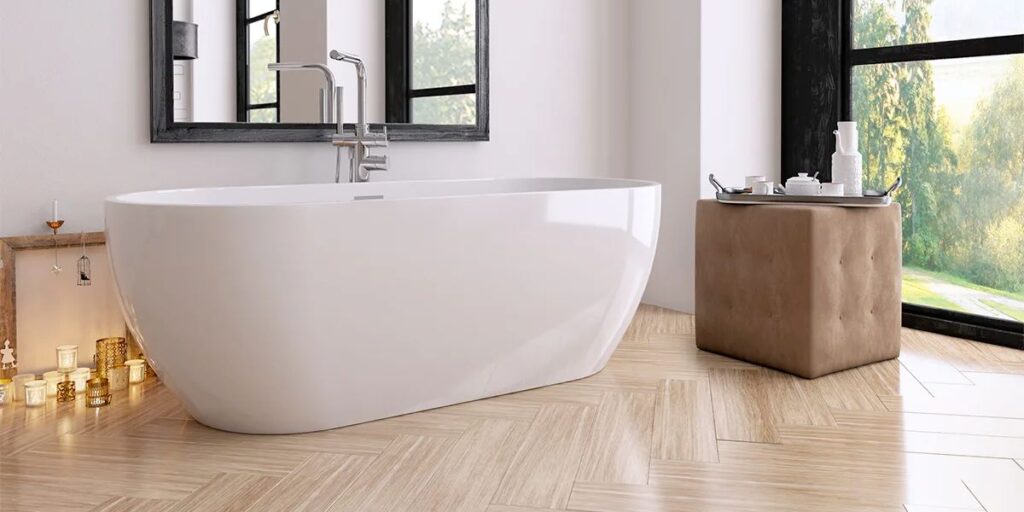
Fiberglass tubs have these advantages:
- Inexpensive – They are significantly cheaper than cast iron or acrylic options, with basic models starting under $200. This makes them a budget-friendly choice.
- Easy to install and replace – Weighing much less than other materials, fiberglass tubs are easier to maneuver into place and remove if needed. This also lowers installation costs.
- Variety of colors – Like acrylic, fiberglass tubs come in many different colors to match your bathroom décor, including white, biscuit, gray, black, and almond shades.
- Lightweight – Fiberglass weighs less than a quarter of cast iron tubs, so no reinforcement is needed under the flooring.
But fiberglass also comes with a few drawbacks:
- Not as durable – The surface is porous, so it’s more likely to stain and scratch over time. Resin can also yellow slightly.
- Easier to damage – If cracked or chipped, repairs on fiberglass are more complicated than with acrylic. It’s prone to showing wear sooner.
- Limited style options – You won’t find as many shapes like curved rims or clawfoot designs. Most have simple rectangular shapes.
- Poor heat retention – Without acrylic’s insulating properties, fiberglass tubs will cool down faster. Your bath water won’t stay hot for as long.
See more Can You Paint a Fiberglass Bathtub? Breathe New Life into Your Bathroom
Key Differences Between the Materials
Now that we’ve covered the basics of each material, let’s directly compare some of the key differences between fiberglass and acrylic bathtubs:
- Durability – Acrylic tubs are better able to resist scratches, dents, and surface damage through years of use. The glossy finish maintains its luster longer than porous fiberglass.
- Cost – Fiberglass tubs are clearly the more budget-friendly choice. Acrylic costs two to three times as much for the materials and professional installation.
- Style options – Acrylic can be molded into more unique shapes and sizes. Fiberglass styles are fairly basic and limited.
- Ease of cleaning – Non-porous acrylic wipes clean easily with less soap scum buildup. Stains are more likely to set into the surface of fiberglass.
- Heat retention – Take a bath in acrylic, and the hot water stays warm for longer thanks to its insulating properties. Fiberglass cannot retain heat as well.
So if your budget allows, acrylic is generally regarded as the higher quality option. But fiberglass works well for basic bathroom needs at an affordable upfront cost.
Acrylic vs Fiberglass: Maintenance and Repairs
To keep either material looking its best and maximize its lifespan, proper maintenance is essential. Here are some key points of comparison:
Acrylic is easier to repair:
Light scratches and scuffs can often be removed by sanding and polishing the surface. Minor chips and cracks can be filled in using special acrylic bonding solutions.
Fiberglass is harder to repair:
Once the resin layer is damaged, repairs are complicated and may result in a patchy appearance. Marks have a tendency to remain visible.
Both require gentle regular cleaning:
For either material, avoid abrasive scouring pads and harsh cleansers which can damage the finish over time. Mild soap and water are best.
Avoid abrasive cleaners:
Don’t use products with acids, ammonia, or bleach on acrylic or fiberglass surfaces as they can dull the glossy finish.
So when cared for properly, acrylic clearly has the edge for maintaining its appearance and resisting damage. But fiberglass can also last many years with gentle cleaning. Be prepared to tackle repairs sooner than with acrylic, however.
Acrylic vs Fiberglass: Installation Considerations
Installing bathtubs takes advance planning and preparation, especially for larger and heavier acrylic models. Here are some things to keep in mind:
- Acrylic is heavier than fiberglass so may require reinforcement under the flooring to support the weight. failure to properly support an acrylic tub can lead to cracks.
- Fiberglass tubs are lighter and easier for DIY-ers to maneuver into place without extra support. But ask a plumber about reinforcement needs in some cases.
- For acrylic, professional installation is highly recommended. The installer needs to carefully level and secure the tub on a well-supported base.
- Fiberglass can be installed by experienced DIYers, but you never want to risk a leak or other issues. Consider all risks before attempting it yourself.
Proper installation is crucial to ensuring your bathtub lasts for years of enjoyment. Don’t cut corners or rush through it. Taking the time to do it right avoids problems down the road.
Costs
- Acrylic: Expect to pay $500 to $1500 to install. More complex styles run $2000+.
- Fiberglass: Around $200 to $800 installed. The cheapest bathtub option.
My Personal Recommendations
Acrylic tubs are best for those wanting a stylish, durable tub that stays looking pristine for years. The higher cost pays off long-term. Go fiberglass for basic functionality on a very tight budget.
For families with kids, I’d recommend acrylic since it resists scratches from bath toys. For rental properties, inexpensive fiberglass tubs may make more sense since they’ll need replacing sooner.
“We’ve had an acrylic tub for over 15 years now and it still looks fabulous. A bit of polishing makes light scratches disappear. Well worth the extra cost.” – Jane, Houston TX
“I’m on a tight budget so went for a basic fiberglass tub. It does the job but shows lots of scratches and staining now after 5 years of use.” – Tim, Denver CO
“Upgraded our rental unit’s old fiberglass tub to acrylic. It cleans up beautifully after each tenant and still looks brand new after 3 years.” – Marissa, Chicago IL
FAQs
Is acrylic or fiberglass easier to clean?
Acrylic is easier to keep clean since its glossy non-porous surface resists soap scum buildup and stains. Fiberglass can absorb stains over time.
How durable is a fiberglass bathtub?
Fiberglass scratches and stains more easily than acrylic. With proper care, it can last 5-10 years but it is prone to damage sooner.
Can you repair a chip or crack in an acrylic tub?
Yes, minor chips and cracks in acrylic can often be repaired using acrylic bonding solutions. More significant damage may require calling a professional.
Which material retains heat the best?
Acrylic retains heat well for a longer lasting warm bath. Fiberglass cannot insulate as effectively so the water cools faster.
Conclusion
When shopping for a new bathtub, weighing the differences between acrylic and fiberglass will help guide your decision. Consider your budget, style preferences, ease of cleaning, and maintenance abilities.
Acrylic tubs are the higher-end option providing exceptional durability, style, and scratch resistance. But they come at a higher price.
For basic functionality at a wallet-friendly cost, fiberglass gets the job done. Just be prepared for more upkeep and sooner repairs.
Get advice from plumbers on the pros and cons of your specific bathroom needs. With proper care, either material can provide a decade or more of soaking relaxation. Take time to make the right long-term investment so that you’ll enjoy years of bubbly bathtime bliss.

William J. Bullock is a licensed plumber with over 15 years of experience installing and repairing bathtubs. He runs his own plumbing company in Greenville and serves residential and commercial clients. William is dedicated to providing honest, transparent advice to help homeowners make informed decisions about their bathroom renovations.
He has established expertise in selecting bathtubs, planning custom installations, diagnosing issues, and completing repairs. William aims to share practical tips and reliable recommendations based on extensive hands-on work. When he isn’t on a job site, William enjoys spending time with his family and volunteering at local community events. He takes pride in delivering quality service and enjoys helping people upgrade their homes.

